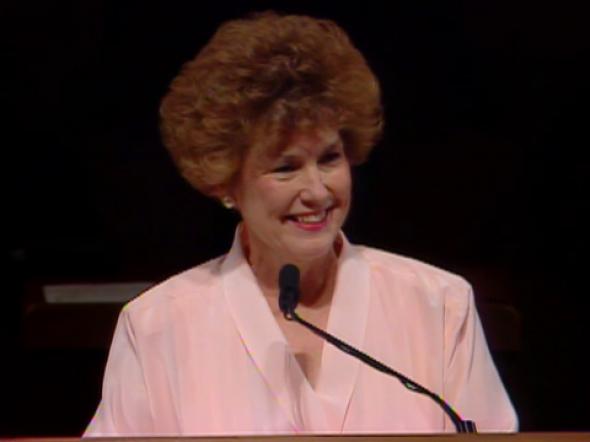
Barbara Woodhead Winder brought structural change to the Relief Society when she served as its President. The Relief Society was so busy reinventing itself, as well as defending itself throughout its existence; it was now time to align itself properly within the kingdom of God; at the side of the Priesthood in works, deeds, and eternal placement. During this time, programs were simplified, boards were eliminated so that there was a more direct correlation, and wards became more accountable over their members.
Barbara was born May 9, 1931, in Midvale, Utah. She had a pretty normal upbringing, however, her parents were not active in the church. Primary teachers and friends encouraged her to attend her meetings. When she met her husband and planned to marry in the temple, sadly, her parents could not be there with her. But, happily, several years later, they themselves would be sealed to one another and all of their children.
As Barbara served in her ward, she was called as a Primary and Young Women’s President. Eventually, she was called to serve on the Young Women’s Board and then the Relief Society Board. She was serving with her husband in the San Diego Mission when she was called as the President of the Relief Society. When President Hinckley called her, he didn’t ask anything about her life or situation. He simply asked: “Are you worthy?” Later, when he met with her, he explained that her presidency was called to create a new pattern from the old tradition of Relief Society.
This new direction would be an emphasis on being a resource and advisor to priesthood leadership with the intent of working side by side with the Brethren in their Priesthood responsibilities. The Relief Society was “to counsel and to sit in council.” The women were to support the mission of the church by emphasizing the building of faith among the women, to live better and share the gospel, to give more service and fulfill spiritual, as well as temporal, needs. The strengthening of families became core as the world moved into threatening positions. And, finally, the Relief Society would sustain the priesthood in their efforts to help all to receive the sacred ordinances and covenants of the temple.
It was during this time that Relief Society, Young Women, and Primary general leaders began meeting together to better stand together in support of the priesthood channel, working together and focusing efforts toward the membership of the church.
With the growth of the church covering all areas of the globe, it was clear that lessons and programs had to simplify. Lessons became more spiritual in nature. The visiting teaching program changed its efforts to ministering, over visiting. Where it could take a day’s wage to purchase gas and travel to all sisters that needed visiting that month, in certain countries, the emphasis became checking up on the needs of sisters and visiting less. It was very important to Barbara that all sisters knew that someone loved them; that the purpose of visiting teaching was to care and see to needs, not fulfill a meaningless duty.
She made this statement about her influence as president of the Relief Society:
It is a new time, it is a change of direction, it is a time to heal, a time to bond women to women and women to men. We can have unity in diversity and diversity in unity. We don’t have to be like one another to enjoy sisterhood. One of the important things we must do is to help the daughters of God know who they are and that they have had an important part in building His kingdom throughout all generations of time… we can be there to help each other and to have understanding. If we don’t do that, we’re not going to be ready for His coming.
When Sis. Winder was released five years later, she was not done with her service. She and her husband accepted the call to reopen the Czechoslovakia Prague Mission. In that country, Barbara spent much of her time standing in line for such basic commodities as bread and meat. She contracted pneumonia there and learned there was no medicine to treat her, so she was sick much of the time. But, as they gathered the small group of Saints who remained faithful during the forty years the mission had been closed, by the end of the year membership had grown to 600 people.
When they returned home they served in the Jordan River Temple Presidency, presided over the Family History missionaries, and served as president and matron of the newly dedicated Nauvoo Temple. And they continued serving in their home ward.
Sis. Winder’s daughter, Susan W. Tanner, was later called as the General Young Women’s President and she would also be the author of Daughters in My Kingdom.
Taken from Faith, Hope, and Charity, by Peterson and Gaunt